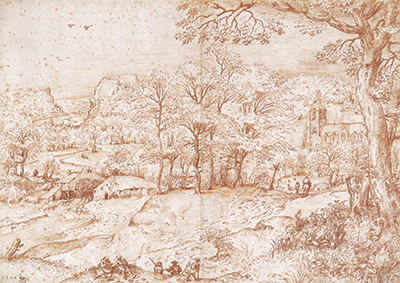This drawing is dated at 1554, when the artist was in his late twenties and travelling around Italy in search of a greater understanding of the achievements of this nation's Renaissance artists.
Here artist Bruegel displays his impressive skills as a draughtsman that were honed over many years of practice and study. He uses the Italian landscape for inspiration here, though the style of the drawing is entirely consistent to much of his work in Northern Europe, with a whole plethora of trees and shrubs, with just a small presence of humanity. This use of single tones also meant that his figures merged more into the scene than would the case with his more famous paintings, as contrasting colours made them stand out much more. If we look more closely into this artwork, plenty of detail starts to appear before our eyes.
Browsing the artwork up close we see several small agricultural buildings dotted around, as well as a church which points out above the surrounding natural environment. Several figures can be seen around, but they do not dominate your eyes in any way. Several men have congregated in the foreground on a mount, perhaps whilst out on a hunt. There are then other on horseback to the right hand side, on their way towards the church. Behind the array of trees is a raised area at the back, and then a simple sky produced with horizontal lines.
This drawing can be found in the collection of the Saatliche Museen in Berlin as part of a selection of different sketches and drawings from the old masters, as we continue to call them. It is listed as having been completed using pen and ink, which is how the artist worked with his drawings for most of his career. He may have been able to work quickly in this format whilst outdoors, or at least make early impressions on his paper before continuing from the comfort of his home or studio. There has been a growing interest in the work of these great names from the past as draughtsman, and a greater acceptance of the importance of this medium.




